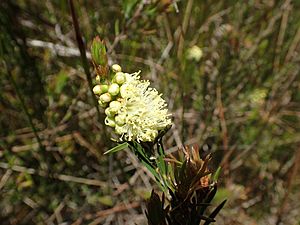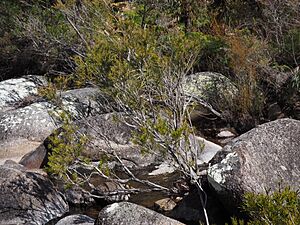River bottlebrush facts for kids
Quick facts for kids River bottlebrush |
|
|---|---|
 |
|
| Melaleuca paludicola leaves and flowers | |
| Scientific classification | |
| Genus: |
Melaleuca
|
| Species: |
paludicola
|
| Synonyms | |
The Melaleuca paludicola, commonly called river bottlebrush, is a plant that belongs to the Myrtaceae family, also known as the myrtle family. This plant is special because it is endemic to eastern Australia, meaning it grows naturally only in that area. (Some plant collections in Australia still use older names like Callistemon sieberi or Callistemon paludosus for this plant.) It can be a shrub or a small tree. It often has flexible, hanging branches, and its new leaves can look pinkish. In summer, it grows spikes of cream, pale yellow, or sometimes pink flowers.
Contents
What the River Bottlebrush Looks Like
The Melaleuca paludicola is a shrub or tree that can grow up to 8 m (30 ft) tall. It has bark that feels like fibers, or on older plants, the bark can be hard and cracked. Its leaves grow one after another along the stem. They are usually 20–68 mm (0.8–3 in) long and 1.3–8 mm (0.05–0.3 in) wide. The leaves are flat, long, and narrow, often with a small point at the end. You can see a clear main vein in the leaf, and 11 to 18 smaller veins that are not as easy to spot.
Flowers and Fruit
The flowers of the river bottlebrush are usually cream to yellow, but sometimes they can be pink. They grow in spikes at the ends of branches. These branches keep growing even after the flowers have bloomed. Flowers also appear on the sides of the branches. Each spike is about 20–30 mm (0.8–1 in) across and has 10 to 40 individual flowers. The petals of the flowers are 2.6–4.2 mm (0.1–0.2 in) long and fall off as the flower gets older. Each flower has many stamens (the parts that produce pollen), usually between 48 and 67. The plant mainly flowers from October to January. After flowering, it produces woody, cup-shaped capsules (fruits) that are 3–4.3 mm (0.1–0.2 in) long.

How the River Bottlebrush Got Its Name
The plant Melaleuca paludicola was officially named in 2006 by a scientist named Lyndley Craven. He moved the plant, which was previously called Callistemon sieberi, into its current genus (a group of closely related plants). The name Callistemon sieberi was first described by another botanist, Augustin Pyramus de Candolle, way back in 1828.
Meaning of the Name
The second part of the plant's scientific name, paludicola, comes from Latin words. Palus means "swamp," "marsh," or "bog". The ending -cola means "inhabitant" or "dweller". So, paludicola means "swamp dweller," which makes sense because of where the plant grows. An older name for this plant was Callistemon paludosus, and the current name was chosen to connect with that earlier name. The Royal Botanic Gardens, Kew also considers Callistemon paludosus to be the same plant as Melaleuca paludicola.
Where the River Bottlebrush Grows
The Melaleuca paludicola is found in several parts of eastern Australia. It grows from Warwick in southeastern Queensland, through New South Wales, and as far inland as the eastern North West Plains. It also grows in the eastern half of Victoria. There is also a separate group of these plants in the Mount Lofty Ranges and Adelaide areas of South Australia. This plant likes to grow in and near rivers, in dry, rocky riverbeds, and in flood channels. These areas often get covered by water when rivers flood.
Using River Bottlebrush in Gardens
Sometimes, Melaleuca paludicola is grown in gardens. When it is, people might still call it Callistemon sieberi. There is a special type of this plant that grows in alpine (mountain) areas. This alpine form is a smaller, bushier, and more rounded shrub. This makes it a good choice for gardens where people want a neater, more formal-looking plant.
Images for kids
-
M. paludicola in the Royal Botanic Gardens, Melbourne (called Callistemon sieberi there)




